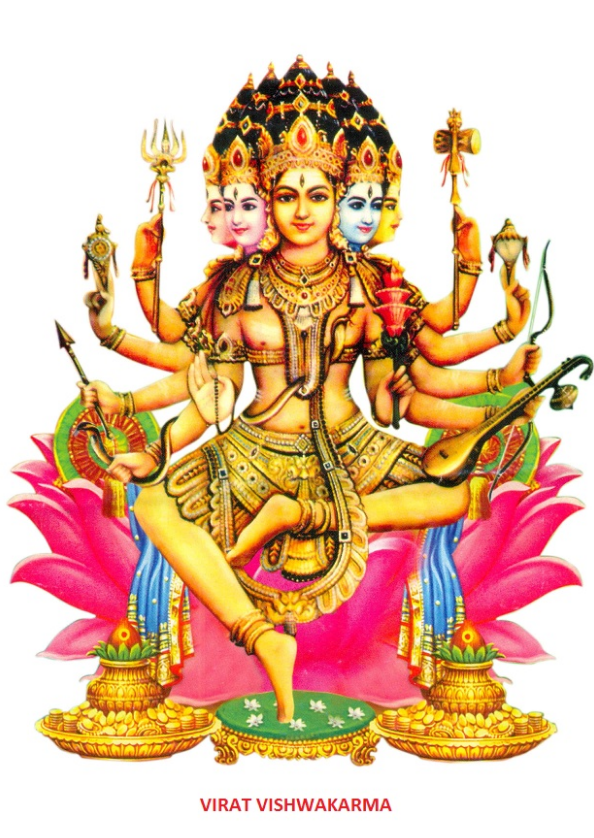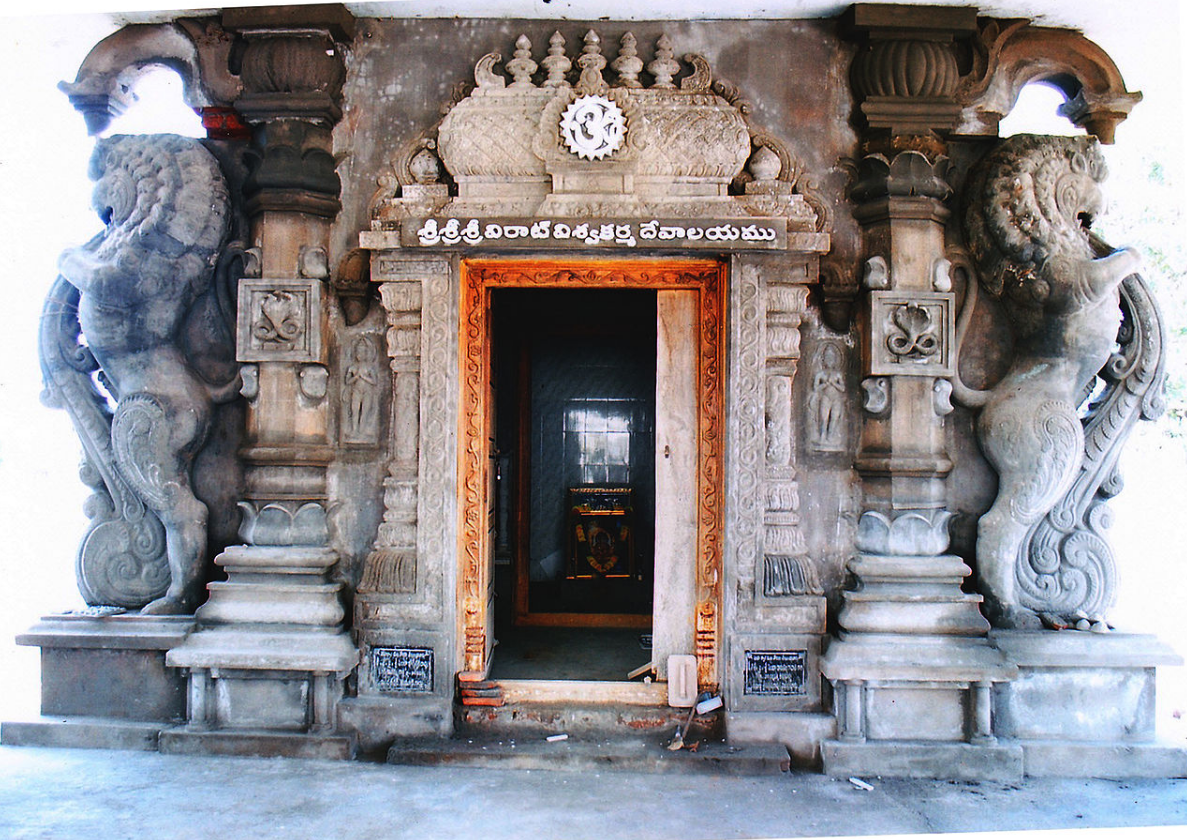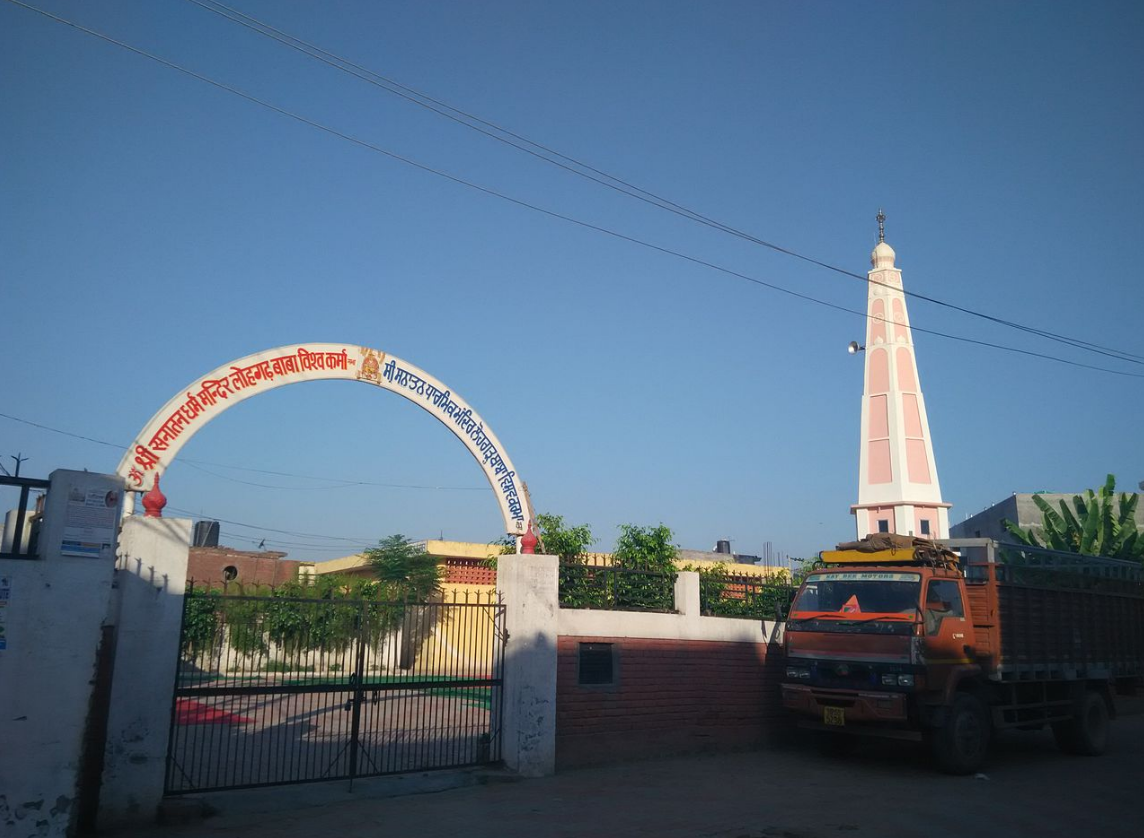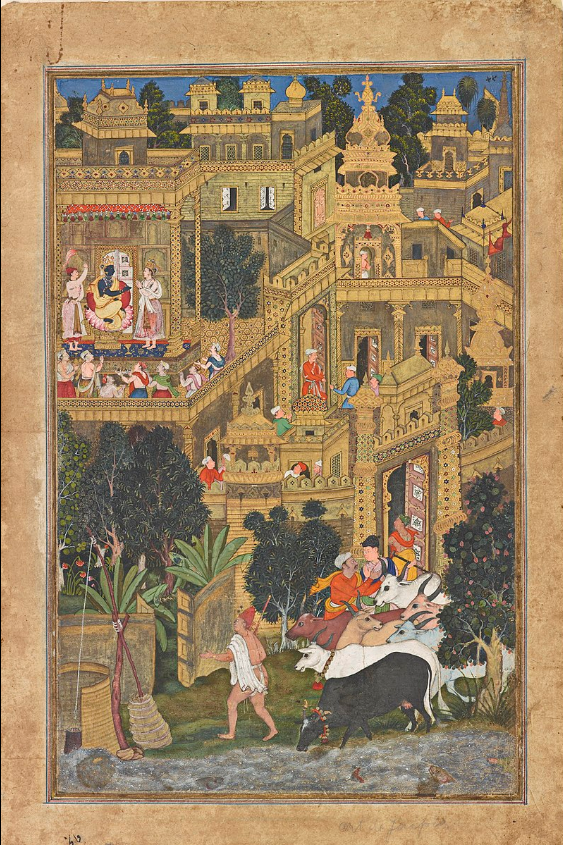Vishvakarman (Sanskrit: विश्वकर्मन्, Viśvakarman; lit. "all creating") is the Personification of ultimate reality and deity of the creative power. He is believed to be one of the ancient architect or engineer who created and taught building of ancient monuments, architectures in Bharat, now India. According to the Rigveda It/He is considered to be the architect, divine engineer of universe from before the advent of time.
- vishvakarman
- viśvakarman
1. In the Vedas
Vishvakarman was originally used as an epithet for any supreme god[1] and as an attribute of Indra and the Sun. The name Vishvakarman occurs five times in the tenth book of the Rigveda. The two hymns of the Rigveda identify Vishvakarman as all-seeing, and having eyes, faces, arms and feet on every side and also has wings. Brahma, the later god of creation, who is four-faced and four-armed resembles him in these aspects. He is represented as being the source of all prosperity, as swift as thought and titled a seer, priest, lord of speech.[2]
The later parts of the Rigveda reveals efforts to find a satisfactory answer to the mysteries regarding the origin of the universe, the creation hymns present in these parts of the Rigveda mention individual creator gods as opposed to the collection of gods and their chiefs (Indra, Varuna, Agni, etc.) creating the world.[3]
Vishwakarma is visualised as the Ultimate Reality (later developed as Brahman) in the Rig Veda,[4] from whose navel all visible things Hiranyagarbha emanate. The same imagery is seen in Yajurveda purusha sukta, in which the divine smith Tvastar emerges from Vishwakarma.[5] In the later puranic period this concept paved the way to the imagery of [[Brahma] and Sadasiva. He is also sometimes referred to as Tvastar.
In the Vedic period the term first appeared as an epithet of Indra, Surya, and Agni. In that time the later developed creator concept of Brahma might have been intertwined with the concept of Vastospati and Bṛhaspati, or Brahmanaspathi[6] In the last phase of vedic period and during the growth of monothesism ,one can see Vishwakarma [the invisible creative power] emerged as the supreme god[7] who was perceived as a hotar, the unborn [Aja] creator and name giver of all other gods who have lot of faces, eyes and feet on every side; and who helps Tvastar, [the visible creative power of viswakarma] in producing all the Heavenly, Earthly and other Celestial realms and preserves them through the exercise of his arms and wings. He sacrificed himself to himself for the evolution of this visible world (Sarvamedha), thus he is Purusha or Narayana( this thing is false as is monotheism)[8] His attributes like Vachaspathy[9] connect him with Brahaspathi (the Guru of Gods). Again, Yajurveda pictured him as the Prajapati[10] and in the Atharva veda he is mentioned as Pashupati.[11] Shwethashwatharopanishad described him as Rudrasiva, the one who is dwelling in all living forms.[12]
According to the above hymn, from Moolastambha purana which is something similar to Nasadeeya suktha It/He was the one who created himself from himself when there was no earth, water, light, air and akasha, and even the Thrimurthies Later in the post vedic and brahmanic period, the term Vishwakarma is appeared both as the Rsi and the Silpi. In yajurveda the term is seen as one of names of pancha risis. Though the term is an epithet of suryanarayana, one of the seven rays of Surya is also known as Viswakarma. Bhauvana Vishwakarma (Atharva/Angirasa Gothra) is a vedic Rsi who was the author of Rg 10–81,82 suktha, (Prabasa Vishwakarma) was probably a silpi and the son of Prabhas, the eighth hermit of the legendary Astam vasu and Yogasiddha, sister of Brihaspati. He is said to have revealed the Sthapatya Veda / Vastu Shastra or fourth Upa-veda, and presides over the sixty-four mechanical arts.
Vishvakarma [ God ] created five prajapathies – from his five faces such as Sadyojāta, Vāmadeva, Aghora, Tatpuruṣha, Īsāna.[13] They are Manu, Maya, Twosta, Silpy, Viswajna and their respective Rishis (Gothra rishis of Vishwakarma (caste))
- Sānaga Brahma Rishi
- Sanāthana Brahma Rishi
- Ahabhuna Brahma Rishi
- Prathna Brahma Rishi
- Suparna Brahma Rishi
 By Santosh.sapps - Own work, CC BY-SA 4.0, https://commons.wikimedia.org/w/index.php?curid=47792713
By Santosh.sapps - Own work, CC BY-SA 4.0, https://commons.wikimedia.org/w/index.php?curid=47792713In later puranas he is sometimes identified with vedic Tvastar.[14] Silpi Vishwakarma is the designer of all the flying chariots of the gods, and all their weapons and divine attributes. Vishwakarma/Tvostar is also credited with creating the missiles used in the mythological era, including the Vajra, the sacred weapon of Lord Indra, from the bones of sage Dadhichi. He is regarded as the supreme worker, the very essence of excellence and quality in craftsmanship.[15]
2. Vishwakarma Puja


Since Vishwakarma is the divine engineer of the world, as a mark of reverence, he is not only worshiped by the engineering and architectural community but also by all professionals. It is customary for craftsmen to worship their tools in his name.
Silpy Vishwakarma is attributed a putative birthday by the Hindu religion. The more philosophical minded argue that it is impossible for the original Creator of everything to be born on a particular day. In Rig veda he is described as Swayambhu[16] So it is a contradiction in terms since that presupposes another creator for Vishwakarma. The Vishwakarma Puja is celebrated in all parts of Nepal and India .
Even among those who believe that there is a birthday there is no agreement as to when it actually occurs. Visvakarma birthday is celebrated on two days under different names:
- Vishwakarma Puja. "Vishwakarma Puja" always celebrated in India on the 17/18 September of every Year.[17]
- Rishi Panchami Dinam. "Rishi Panchami Dinam" literally means ‘the day of the solidarity of five rishis.’ Those who celebrate this day believe that Vishwakarma did not have a birthday like the mortals but only a commemoration day in which his five children (supposedly five rishis) came together to declare their solidarity and pray to their illustrious father. This day follows the rules of the Hindu calendar and changes with every year. The five groups among the Vishwakarma community also celebrate this as an auspicious day in commemoration of their patron god at present.[18]
- Visvakarma Jayanthi. Vishwakarma Jayanthi is celebrated by all industrial houses, artists, craftsmen, and weavers. The Vedic Jayanthi is celebrated on Magha Shukla Trayodashi is celebrated culturally. The festival is observed on Kanya Sankranti (16 September in 2016)[19] which follows the Ganesh Puja. It was on this particular day that the forefathers of the present Visvakarma people invented the plough and gave it to humanity. The plough represents both the artisan trade as well as agriculture and therefore becomes the representative symbol of the ancient Indian civilisation. It changed the course of human history altogether. This was a change from ‘local mob culture to universal human culture’ and Vishwakarmas of India pioneered it. Coincidentally, this also becomes the birthday of Rsi/Silpi Visvakarma. So Indians in the past celebrated this day of many illustrious conjunctions as an occasion to honor Vishwakarma and his descendants.
Vishvakarman is a particular god of Hindu railwaymen in India.[20]
3. Architectural Wonders
Hindu scriptures describe many of Vishwakarma's architectural accomplishments.
Through the four yugas (aeons of Hindu mythology), he had built several towns and temples for the gods. Among them were, in chronological order, Svarga (Heaven) in the Satya Yuga, Lanka in the treta Yuga, and Dwarka (Krishna's capital) in the dwapara Yuga.
3.1. Jagannath Ppuri, Temple
The Lord of Architecture is also supposed to have built the three deities Lord Jagannath, Lord Balabhadra, Goddess Subhadra along with Sudarshana Chakra in the Shreekshretra Jagannath Temple .
3.2. Dwarka

Viswakarma is also supposed to have built Dwarka overnight.[21]
3.3. Pushpaka Vimana
Vishwakarma is said to have built the Pushpaka Vimana from the sun dust from his son-in-law Surya and given it to Ravana.
3.4. Trishul
Also made from the sun dust, it was given to lord Shiva.
3.5. Sudarshana Chakra
Also made from the sun dust, it was given to lord Vishnu.
3.6. Vajra
The Vajra was made from sage Dadichi's bones for Indra to kill Vritra.
References
- "Vishvakarman | Hindu mythology" (in en). https://www.britannica.com/topic/Vishvakarman.
- Macdonell, Arthur Anthony (1898) (in en). Vedic Mythology. Motilal Banarsidass. ISBN 9788120811133. https://books.google.com/?id=b7Meabtj8mcC&pg=PA41&lpg=PA41&dq=primeval+waters+vedas#v=snippet&q=Visvakarman&f=false.
- Dhavamony, Mariasusai (1982) (in en). Classical Hinduism. Gregorian Biblical BookShop. ISBN 9788876524820. https://books.google.com/?id=DD0w_IMFA8gC&pg=PA48&lpg=PA48&dq=rig+10.82.5#v=onepage&q=rig%2010.82.5&f=false.
- Thamid garbham pradhamam dhadra apo yatra deva samagachanta visve Aja asya nabha--- (Ṛg Veda, 10.82.5), Aja is an epithet for Upanishadic Brahman, Ondian philosophy and religion by Bibhu/Minakshi Padhi
- Abya sambootha prutvi rasacha viswakarmana samavarthatadi tasya tvoshta vidatha roopameti tat purshasya visvam ajanamagre
- Sadyayo janayan brahma deva vasthospathim vratapannira takshan Rg veda
- Sam bahubhyam dhamathy sampatathrair dyavabhoomy janayanth Deva Eka [Rg 10 81, Indian nireeswaravadam by D.B.Chathopadyaya, p43, Hindu civilisation by Radakumar mukhargy p 89
- Viswakarman havisha vrutharra swayam yajaswa-rig 10–81, moreover first part of viswakarma sukta and purusha sukta and narayanasukta are almost same, Vedic cosmology, Rajendra verma, page 80
- Vachaspathim viswakarmana moothaye manojuvam vachae adyahuvema Rig & Yajurveda
- Shukla Yajurveda 18–43 Prajapathir viswakarma mano gandharvasthasya .... Jaiminiya Brahmana – 2.233; Satapatha Brahmana – 8.2.3.13, 8.2.1.10, 7.4.2.5; Shankhayana Aranyaka – 2.17; Aitareya Brahmana – 4.22.3; Maitrayani Samhita −1.3.35, 3.2.3; Taittiriya Brahmana – 3.7.9.7; Apastamba Shrauta Sutra – 9.16.7; Vajasaneyi-Madhyandina Samhita – 12.61.
- Ya eshe pashupathy .......viswakarma prajayam samrarana 2–34,2–34 Atharva veda
- Yeshadevo viswakarma mahatma....zz 4–17
- TS 4.3.2), as per Vasishtha Purana 3.6.11
- Monier-Williams (1899) p. 994.
- Coomaraswamy (1979), p. 79.
- Yo na pita janitha yo vidata, Rig veda
- "Vishwakarma Puja in Hindu Calendar". https://www.calendarlabs.com/holidays/hindu/vishwakarma-puja.php.
- Achary, Subramanian Matathinkal (1995).
- http://www.festivalsofindia.in/kanya-sankranti/index.aspx
- documentary Monsoon Railway, directed by Gerry Troyna, shown on Yesterday (TV channel) 5pm to 7 pm (UK time) Sunday 28 January 2018
- Archer, W. G. (2007). The Loves of Krishna in Indian Painting and poetry. Echo Library. p. 44. ISBN 9781406825404.
